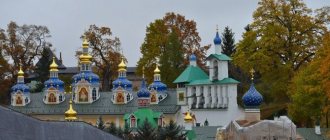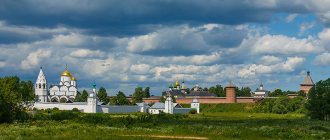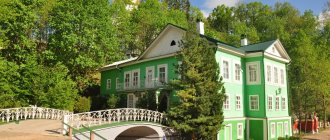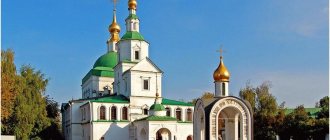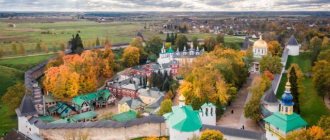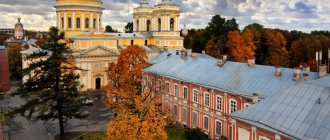Story
According to ancient legend, not far from Pskov, people from the Kiev Pechersk monastery lived in a cave, who fled to these lands due to numerous raids by the Crimean Tatars. The names of the hermits are unknown; only the name of one of them, St. Mark, has been preserved. However, the monastery on this site was founded much later, after the death of the monk.
In 1470, Hieromonk Jonah, a former priest of the St. George Church in the city of Yuryev (now the city of Tartu), settled in the cave, who built the Church of the Assumption of the Blessed Virgin Mary in a sandy hill near the Kamenets stream. The founding date of the temple is considered to be 1473, when the built church was consecrated.
Soon, the owner of the land on which the caves were located gave the ascetic this plot to found a monastery. Thus, on the western borders of Rus', 20 kilometers from the Livonian fortress of Neuhausen, the famous Pskov-Pechersky Monastery appeared.
In 1510, when Jonah had already died, the Pskov lands, and with them the monastery, became part of the Moscow state. From this time on, a new stage in the existence of the monastery begins.
How to get to Pskov by train
You can get to the Pskov-Pechersk monastery by train both through Moscow and St. Petersburg. But trains only go to Pskov.
Trains from Moscow
- Daily route . Train No. 010A “Moscow-Pskov” runs daily from Leningradsky Station. Departure time from Moscow is 18:00. 30 min. Arrival in Pskov - at 7 o'clock. 30 min. A reserved seat ticket will cost about 2 thousand rubles.
- On even days . On even days you can travel by train No. 098A Moscow-Pskov. It departs from Leningradsky station at 15:00. 35 min. He will be in Pskov at 5 o'clock. 00 min. The price of a reserved seat is 1450 rubles. Arriving at 5 o'clock in the morning is convenient because those people who are short on time can make it to the monastery for the Liturgy if they take a taxi.
Trains from St. Petersburg
Unfortunately, now pilgrims cannot travel directly from St. Petersburg to Pechory by train. Only with a transfer.
You can get to Pskov from St. Petersburg by taking the following trains:
- St. Petersburg - Stroganovo and Stroganovo - Pskov;
- St. Petersburg - Luga and Luga - Pskov.
The schedule of these trains is designed so that you can immediately change from one train to another, without interruption.
But from Pskov you still need to get to Pechory, a city in the Pskov region, where the monastery is located. The city itself is located three kilometers from the Pechory-Pskovskiye railway station.
Taxi from Pskov to the monastery
If you arrive in Pskov at 5 o’clock in the morning by Moscow train, you will not be able to take the bus, since they do not yet run at that time. In this case, you will have to take a taxi. The average cost of such a trip is 1 thousand rubles. In the summer, taxi drivers sometimes “raise” the price, but if you haggle, you can get closer to the average price. The price of a bus ticket ranges from 120−150 rubles. If you go with a group, you can easily spend money on a taxi. Usually drivers meet those arriving by train in the square near the railway station. Travel time by car is 40 minutes.
Strengthening the monastery
The monastery was located on the border between Russia and Livonia and was attacked more than once by the Germans, Swedes and Poles. Given this important strategic importance, the Moscow authorities are strengthening the monastery with fortress walls.
The largest work to strengthen the fortress was carried out under Ivan the Terrible, in 1552–1565. During the same period, the St. Nicholas Church with a bell tower was erected above the Holy Gate with the participation of Pavel Zabolotny (monastically Paphnutius).
The fortress walls and towers of the Pskov-Pechersky Monastery are built from local limestone, and the towers have different shapes and sizes.
The land on which the monastery is located is uneven and a stream flows through it. The construction of the walls was carried out taking into account these natural factors - the two towers of the fortress stand above streams flowing through specially installed gratings.
In 1570, bloody events took place in the monastery. Ivan the Terrible at the Holy Gate killed the abbot, hegumen Cornelius, and one of his students, Vassian Muromtsev.
According to legend, Ivan IV suspected the abbot of having connections with the boyar opposition; according to another version, in his writings Cornelius condemned the cruelty of the tsar. In connection with the tragic events, the road leading to the monastery was called the “Bloody Path”, since it was covered in blood when the monks carried the murdered abbot from the Holy Gate to the cave in which he was buried.
There was always a military garrison in the monastery, and in case of danger, local residents could take refuge here.
Caves and services
- Caves . One of the most interesting questions for pilgrims is: Is it possible to get to the Holy Caves? - Yes, you can. You can go to Near, where the relics of the Pskov-Pechersk elders are located, alone. But to go to the Far Ones, you need an organized group. As a rule, it forms quickly and, by asking for the blessing of the monk accompanying it, you can join it.
- Schedule of services . In the Pskov-Pechersk monastery, services are performed daily, with two Divine Liturgies. Depending on the day of the week and the type of service, the morning service begins at 6, 7, 10 o'clock, and the evening in the summer usually starts at 18 o'clock. Details of the schedule of services can be seen on the monastery website and at the entrance to the monastery.
The monastery during the war with King Stephen Batory
In 1581, during the war with the Polish king Stefan Batory, the fortress was fired upon from cannons, which pierced one of its walls. Russian soldiers went on the attack and repulsed the enemy.
Batory again sent his detachment to the fortress and ordered not to return without victory. This time the enemies destroyed the fortress wall on both sides and tried to take the fortress by storm, but again failed. As a result, the soldiers of Stefan Batory never took the monastery fortress.
In subsequent years, the fortress was attacked by Swedes, Polish troops and again by Swedes. Only once was the enemy able to break into the fortress: this happened at night, and in the morning the enemy was forced to leave the fortification.
The chronicle also testifies to the heroic defense of the defenders of the fortress against the detachments of Pan Lisovsky and Lithuanian Hetman Jan Chodkiewicz.
Where to stay
- "The Pilgrim's House" . Recently, the Pskov-Pechora Monastery opened a “Pilgrim’s House”. It is located two kilometers from the monastery. His address: Pechory, Pskov region, st. Yuryevskaya, house No. 82. To settle in it, it is better to agree in advance. This can be done by phone: 8-(81148) -2−32−27, or by writing an e-mail to the address. You can also contact dompalppm on Skype.
- "Pechory-Park" . You can also stay at the Pechory-Park Hotel, which is located just 500 meters from the monastery. A double room on the first day will cost 1,800 rubles, and on the second - 1,500. When checking in from Sunday to Thursday, pensioners are given a fairly decent discount of 20%. You can book a room and find out comprehensive information on the hotel website.
- "Planet" and "Your Shore" . There is also a Planet Hotel in Pechora. But pilgrims don’t stay there often, as they prefer small hotels. You can find out about them on the monastery website. One of these hotels is “Your Beach”. Here one place costs 500 rubles per day. Wi-Fi is provided and bicycles can be rented.
Defense during the Northern War
By the beginning of the 18th century, the fortress was reinforced with earthen ramparts and bastions, and one of the bastions was founded by Peter the Great himself. In addition, earthen embankments and ditches were made. A new weapon was installed on the earthen bastions.
The Swedes attacked the Pskov-Pechersky Monastery in 1701, and then in 1703, but thanks to good fortification, all enemy campaigns were repulsed, and the enemy suffered significant losses.
In 1709, Russian soldiers under the leadership of Peter the Great won a victory near Poltava and the danger to the monastery decreased.
For some time, the fortress still continued to play the role of an important outpost on the western borders of the Russian state, but after the conclusion of the Treaty of Nystadt in 1721, the Pskov-Pechersky Monastery began to lose its military significance and remained only an important religious center in the north-west of the country.
Fortress of the western borders of Rus'
The proximity to European states constantly exposed the Pskov-Pechersk monastery to the danger of being conquered by the Latins. The Pechersk Monastery was attacked by Polish-Lithuanian invaders at the end of the 16th century.
In the fall of 1581, the wall of the Annunciation Church was undermined. This gave the enemy the opportunity to break through. Then the monks brought to the wall the main shrine of the Pechersk monastery - the icon of the Dormition of the Virgin Mary.
This is interesting! Praying and asking the Mother of God for protection, the monks saw a miracle - all the attacks were miraculously repelled.
There is evidence of this battle in the office of the Polish king: “They go on the attack, as if an invisible wall does not allow them to go further.”
The Pskov-Pechersk monastery stands as an indestructible fortress on the border territory of Russia.
During the reign of Peter I, the monastery was strengthened with additional bastions. This made it possible to stop the Swedish troops and maintain state borders at the beginning of the 18th century.
Interesting! Visit to Nikolo Ugreshsky Monastery
In the war with Napoleon of 1812, God's mercy again appeared at the Pechersk monastery and the patronage of the Mother of God appeared at the moment the occupation of the Pskov lands began. When the procession of the cross by the Pskovites with the miraculous icons of the Mother of God “Tenderness” and “Assumption” took place, the French not only did not take Pskov, but Polotsk was also recaptured by the Russian army.
The honor of this battle in the Pechersk monastery was immortalized by the church in honor of the Archangel of the heavenly army, Michael. The times of the October Troubles of 1917 and the Great Patriotic War are described in the monastery chronicle as times of difficult trials and temptations.
Since Pechory borders the Baltic states, the German army quickly began to advance inland. The monastic rank was interrogated and accused of collaborating with the German occupiers, which was not true.
In the post-war years, through the efforts of Archimandrites Pimen (1949-1954) and Alypiy (1959 -1975), destroyed buildings and damaged churches in the Pechersky Monastery were restored.
We were able to begin restoration of the walls of the Pskov-Pechersk monastery, which had been destroyed since the 17th century.
Despite the accusations from the Soviet government, the Pechersk Spiritual Center proved not only its non-involvement in treasonous actions, but also, based on living evidence, proved its active participation in helping Soviet reconnaissance soldiers.
Pskov-Pechersky Monastery - monuments
Among the surviving monuments the following can be noted:
- Church of St. Nicholas the Gatekeeper with a belfry from 1565
- St. Michael's Cathedral, located on a high place, was built in the classical style in 1827. This is the largest building, the dome of which is visible even at the entrance to the monastery
- To the east of the Assumption Church in 1523 a two-tier belfry with 17 bells was built
- The Annunciation Church, built by the Monk Cornelius in 1540, in 1870 the Sretenskaya Church was added to it
- The 17th-century sacristy, a three-tiered building, has a festive, elegant appearance: its walls are painted red, and the window casings and sashes are white.
- The Assumption Cave Cathedral is the main and oldest cathedral church, consecrated on August 15 (28), 1473, on the day of the great feast of the Dormition of the Blessed Virgin Mary.
The stone fortress walls with nine powerful towers survived:
- Taylovskaya
- The Tower of the Upper Grilles, distinguished by its slender proportions and height of almost 25 meters. In total, it has six combat tiers, and other towers have four or five tiers each
- The Tararygin Tower, destroyed by the Swedes in 1615, was restored in a slightly modified form
- The Izborsk Tower is interesting because its gates are protected by devices similar to the zakhabs of some fortresses of North-Western Rus' (zahabs are a long corridor that protected the fortress gates)
- Blagoveshchenskaya
- Tower of the Lower Lattices
- The Nikolskaya gate tower was built next to the Nikolskaya Church, erected during the time of Abbot Cornelius
- The passage Petrovskaya Tower was built after the Time of Troubles, in the 30s of the 17th century, then it was necessary to redo the section of the fortress walls closest to it
- Prison tower.
On the territory of the monastery, ancient battlements and loopholes, military passages and the remains of earthen fortifications erected under Peter I have also been preserved.
Buses
From Pskov - to Pechory
- To find the bus station, you need to stand with your back to the railway station, turn to the left and go in that direction. After five minutes of walking through the square, you can see it.
- All buses, except those passing through Izborsk, travel to Pechory for about 1 hour. They arrive at the main square of the city, from which it is very close to the monastery walls. You need to pay attention to the fact that buses traveling through Stary Izborsk take longer on the way (the time difference can be seen in the schedule). Therefore, if the departure time of such a bus is earlier than others, it is better to skip it.
From St. Petersburg to the monastery
- Direct transportation on the route St. Petersburg - Pechory is carried out every day from the Rossiya Hotel. Departure time is 17:00. 30 minutes, arrival time - 22 hours. 15 minutes. Ticket price: 550 rubles.
- Minibuses from St. Petersburg also go to the monastery. Even though these are minibuses, they are not like ordinary cramped minibuses. These are comfortable cars, not inferior in convenience to modern intercity buses.
From St. Petersburg - to Pskov
Minibuses also run from St. Petersburg to Pskov. For example, transport leaves five times a day. Travel time is approximately 4 hours 30 minutes. They make one stop in Luga. The inconvenience is that you need to “fit into” the transport schedule going to Pechory.
One thought on “Pskov-Pechersky Monastery”
- Andrew
September 14, 2017Reply The first tabernacle “Holy”: from Matthew the holy gospel, from Mark the holy gospel, from Luke the holy gospel, from John the holy gospel. Second Tabernacle “Holy of Holies”: from Luke the most holy gospel, from Matthew the most holy gospel, from Mark the most holy gospel, from John the most holy gospel...
Pskov-Pechersk Icon of the Mother of God “Tenderness”
There are several miraculous icons in this place. For example:
- Image of the Dormition of the Mother of God
- Mother of God "Tenderness"
- Face of Saint Nicholas
The greatest fame of the monastery came from conversations about healings that took place under the intercession of the Mother of God. It is in the Assumption Church that there is a list of the Pskov-Pechersk Mother of God “Tenderness”, which created a large number of different miracles.
This face was painted by order of Hieromonk Arseny from the Vladimir image of the Mother of God. Hegumen Cornelius brought it during his mentorship to the monastery. But Tsar Feodor Ioannovich ordered to decorate it with precious stones and pearls. After which she went to the defenders of Pskov. It was at that time that the siege of the Pskov Kremlin lasted 5 months, but ended unsuccessfully. In memory of this event, every year on the seventh week after Easter a religious procession was carried from the monastery to Pskov.
The best article for you, go to: Alexander-Svirsky Monastery
Nowadays, such a religious procession is performed inside the monastery. The same event takes place on October 7/20 in honor of the feast of the Pskov-Pechersk Icon “Tenderness”.
This holy image is known for the miracles that happened next to it:
- healing the blind, healing tendons, and other ailments;
- protection from military invasions;
- obstacle of destruction.
Most people cured their illnesses, solved various problems next to this face, and after that spread the fame of it. The number of pilgrims is growing every year.
Many people turn to her for:
- requests for protection,
- the gift of health,
- bringing peace
- finding a family,
- motherhood,
- getting rid of pride,
- successful pregnancy outcome.
You can come to the monastery at any time and bow to the holy face, but there are certain days to celebrate it. The celebration of this icon takes place:
- May 7/20,
- May 21/June 3,
- June 23/July 6,
- August 26/September 8,
- October 7/20.
It is on these days that hundreds of pilgrims visit the Pskov-Pechersk monastery.


